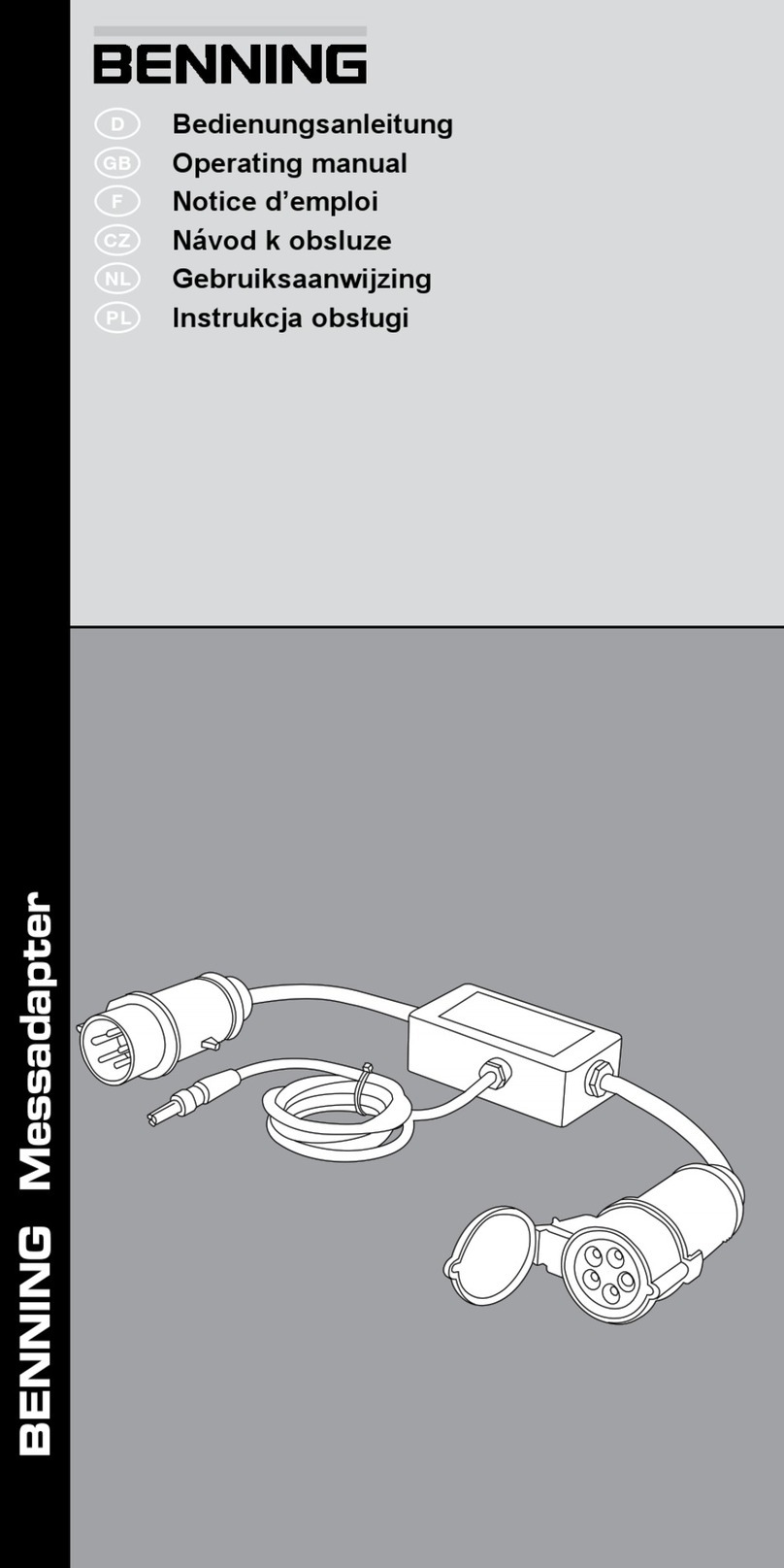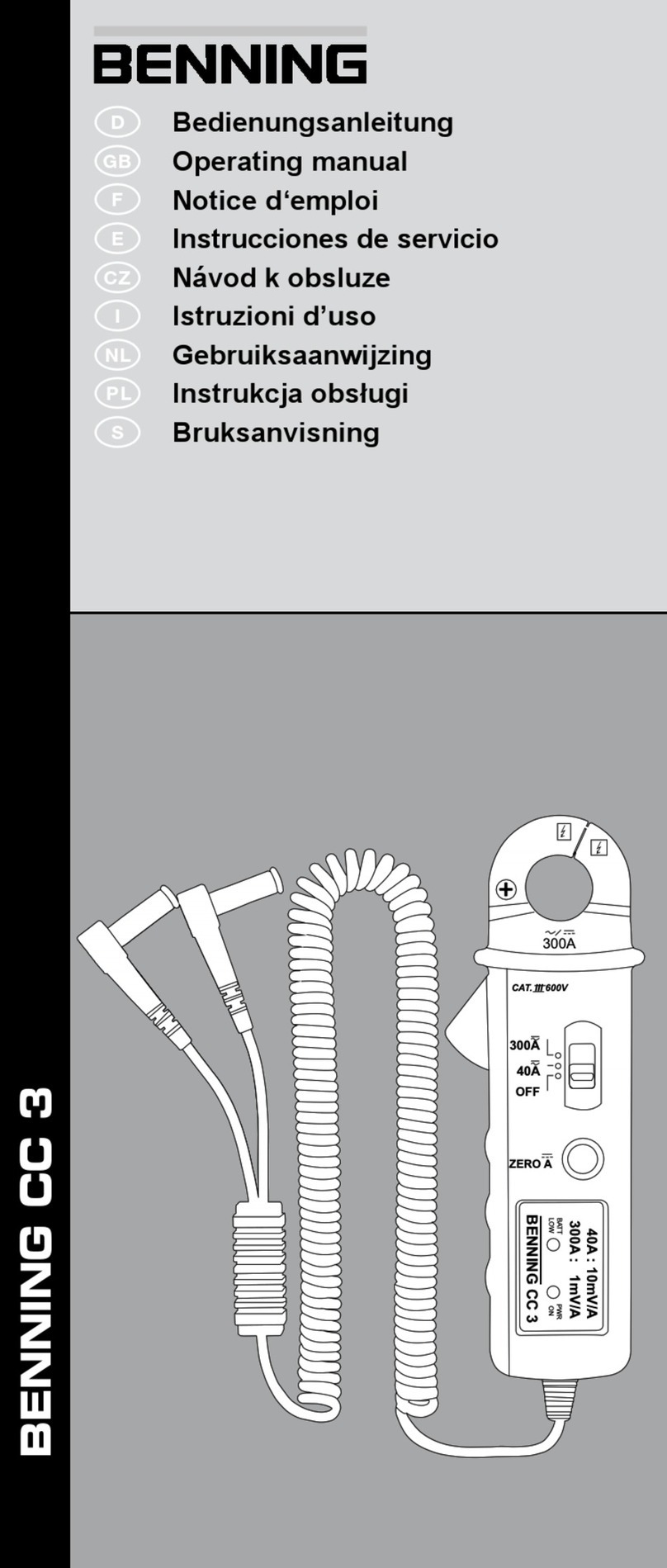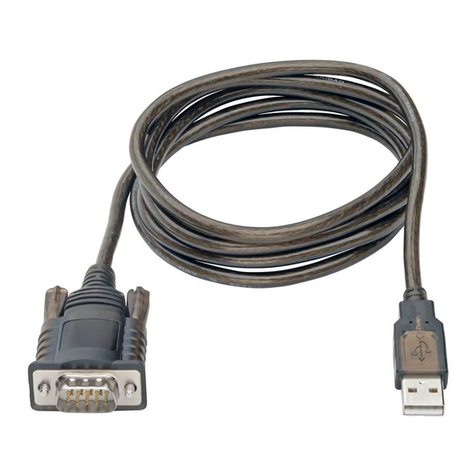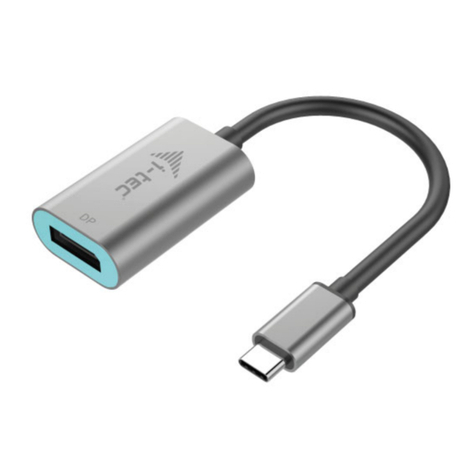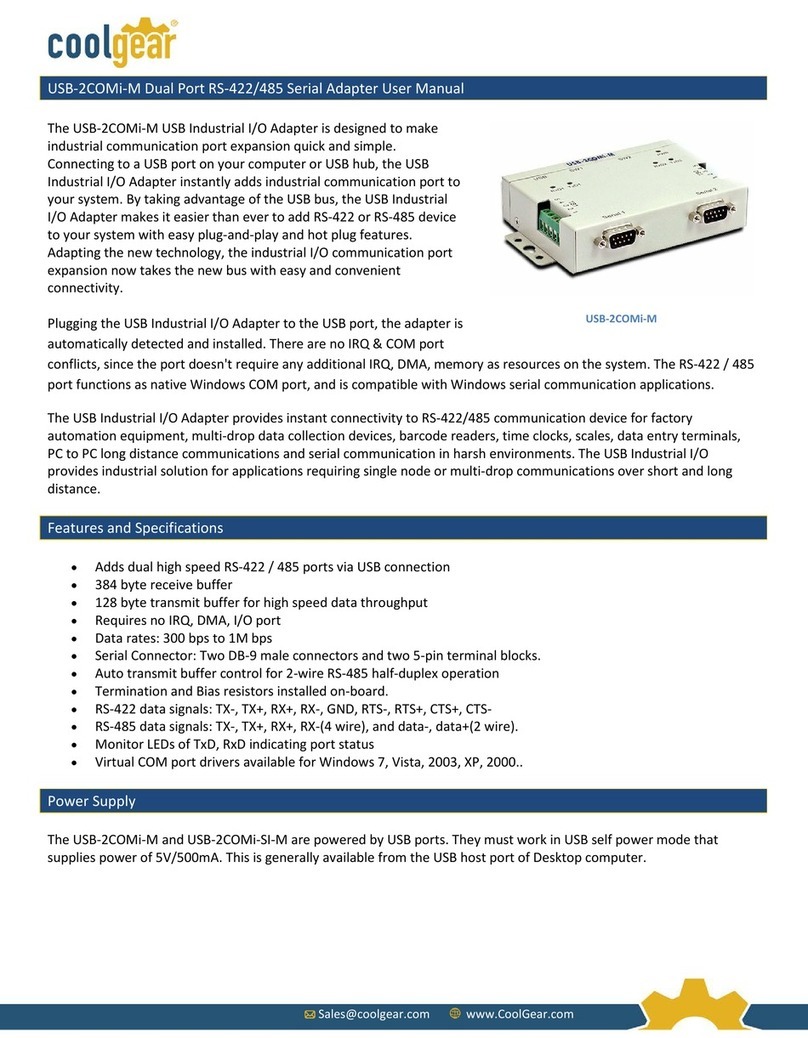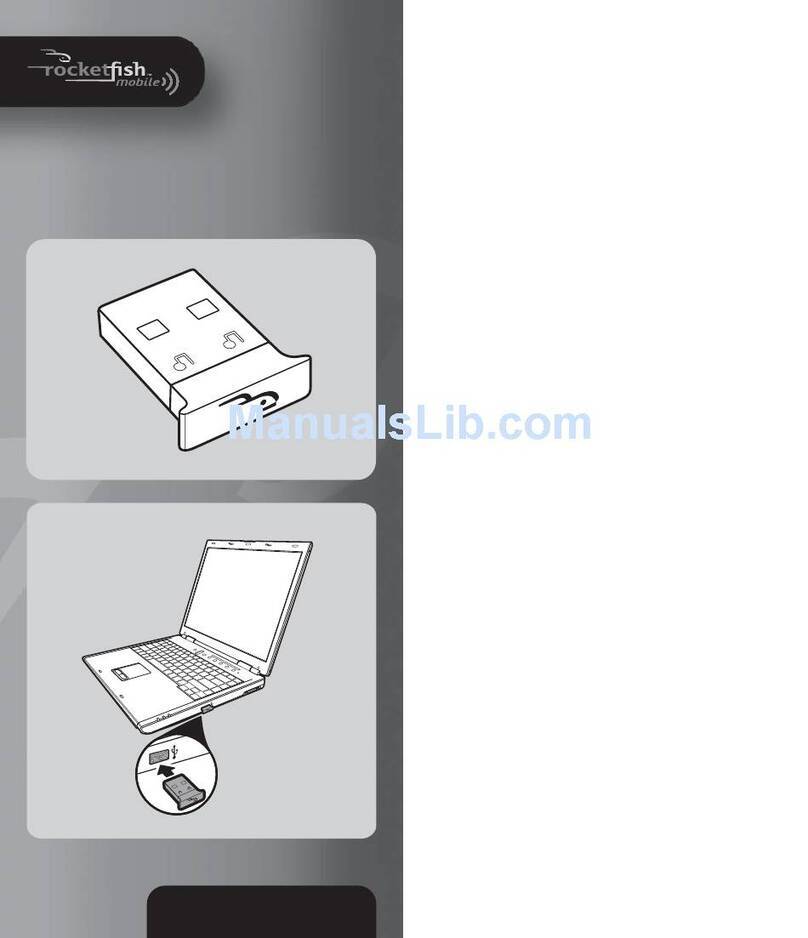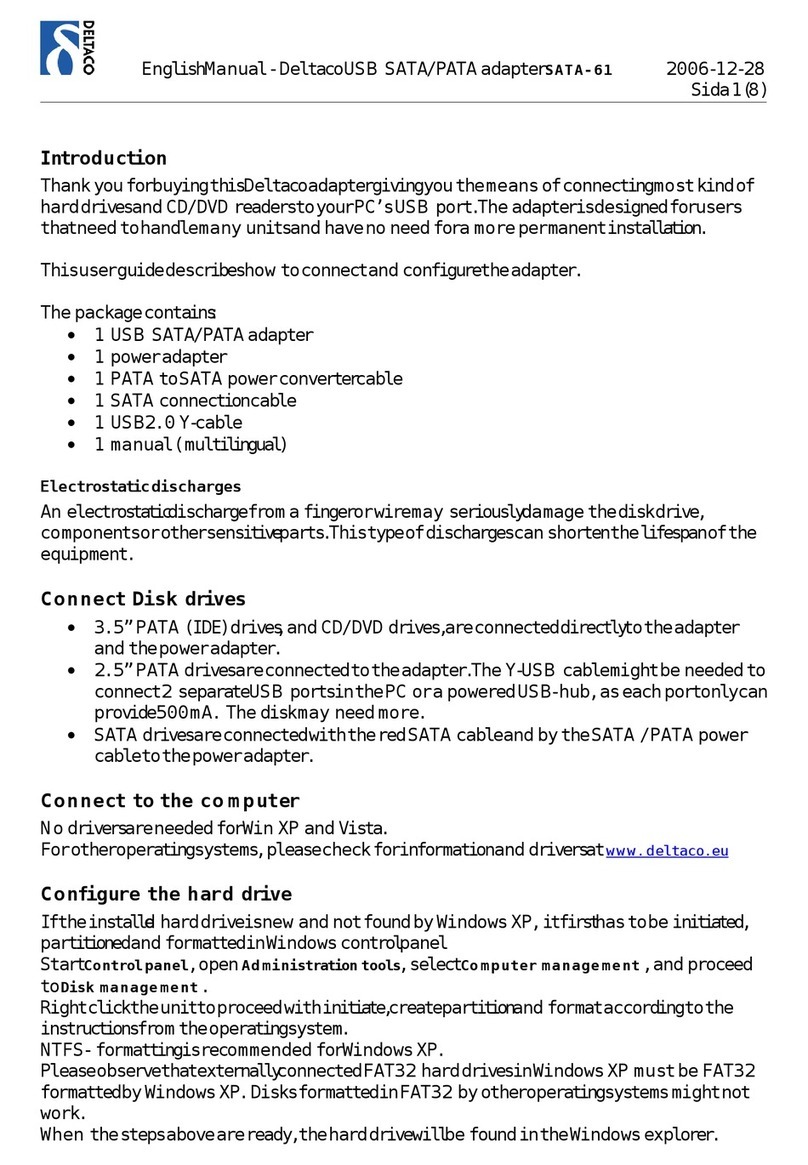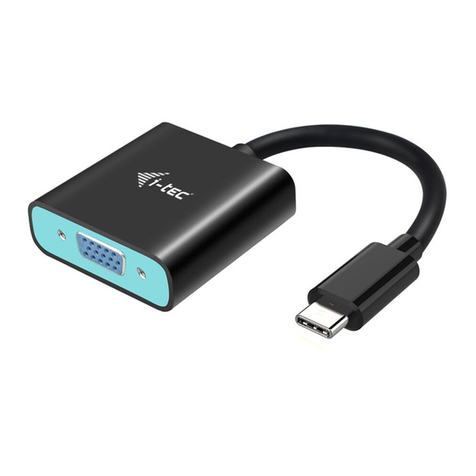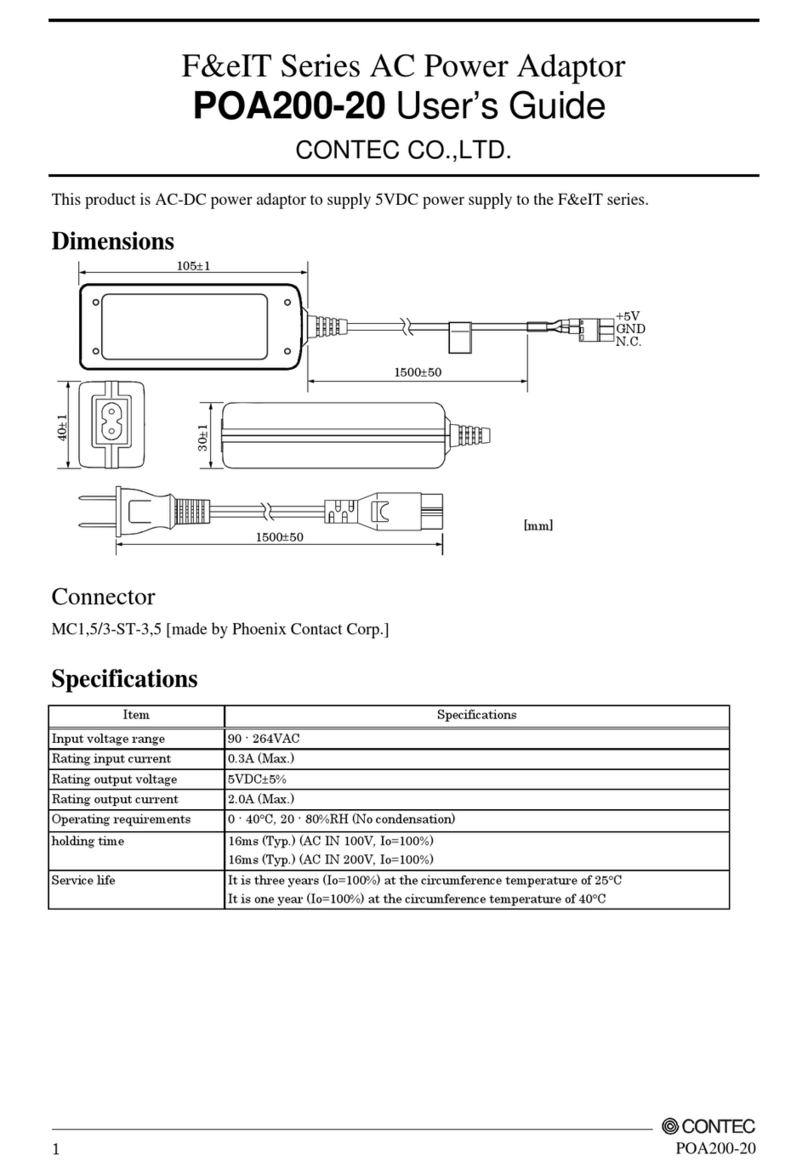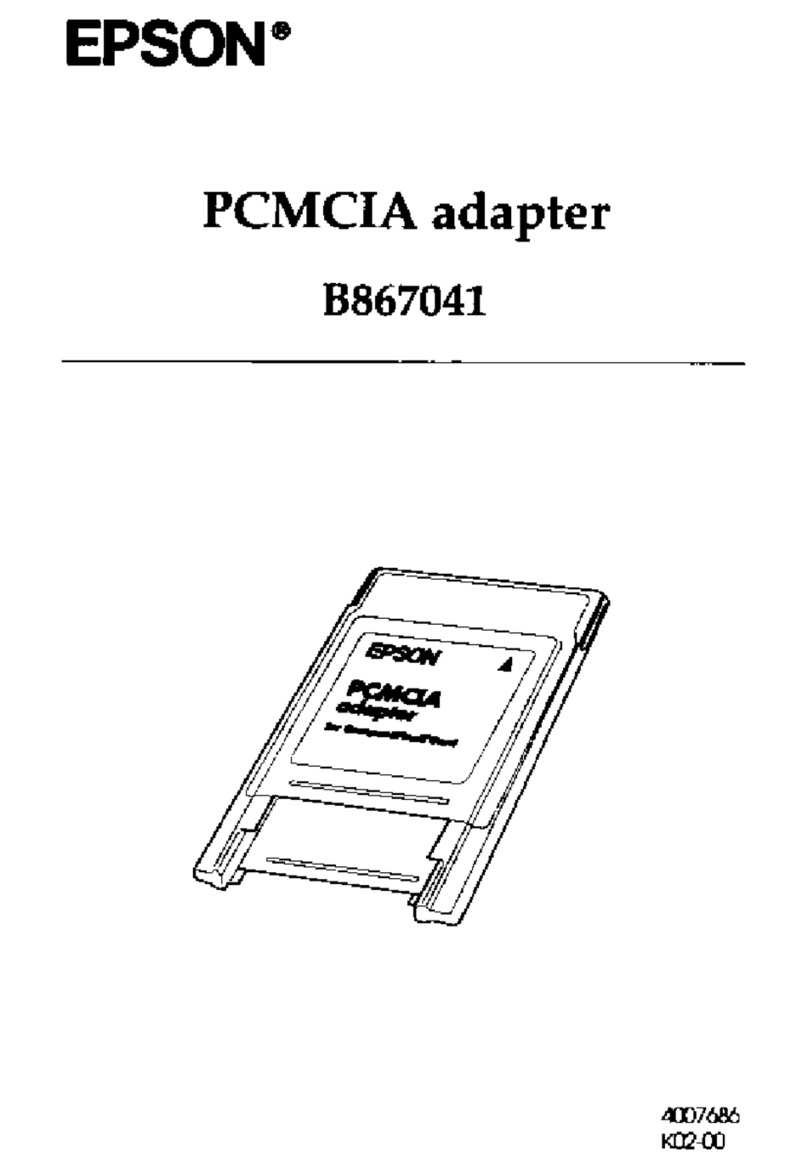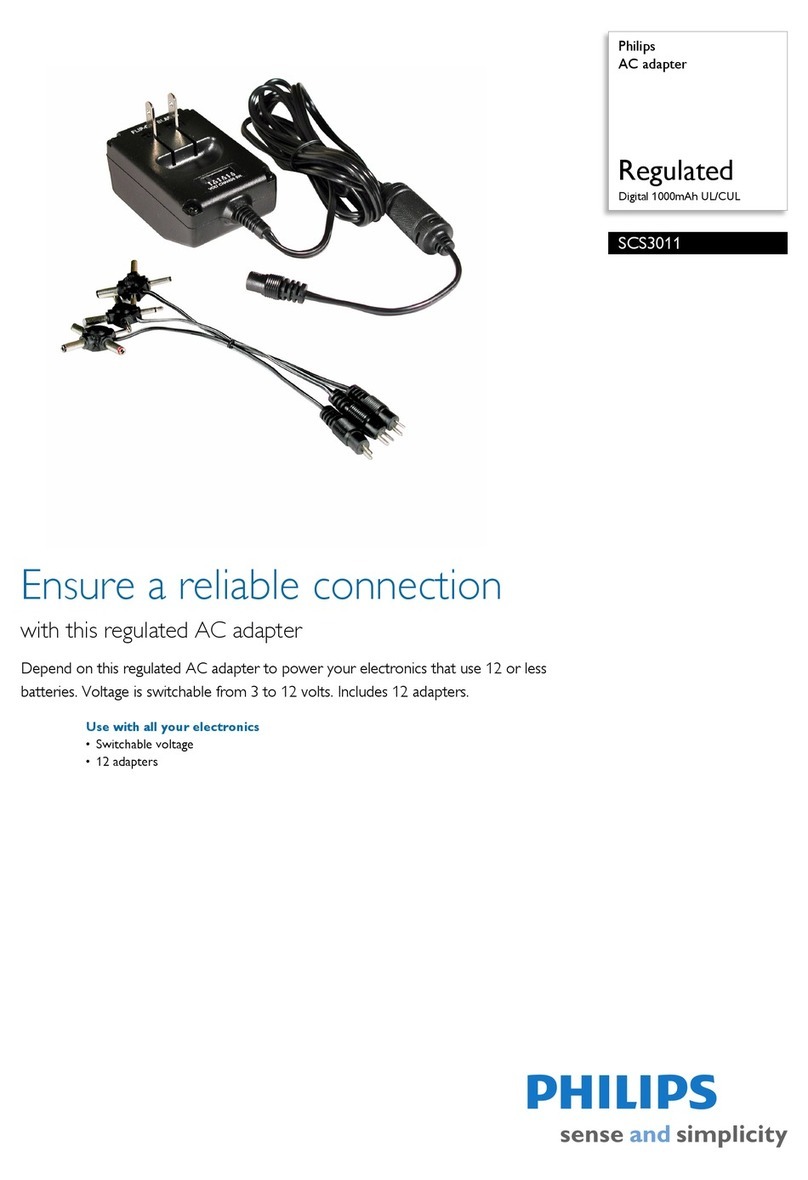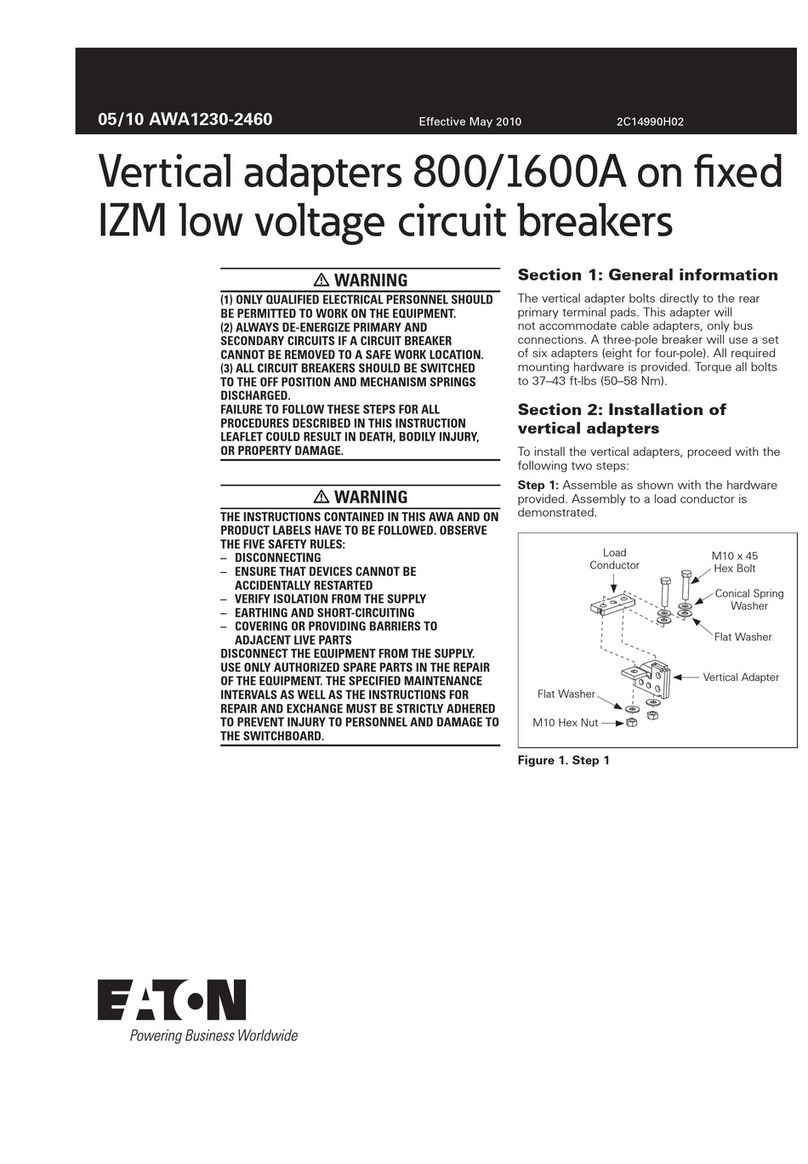Benning MA 4 User manual

5116 de
Version 1.04
10218133
08.09.2020
BENNING MA 4
CEE measuring adapter (5-pin/3-pin)
Operating manual
Original English version


I
Table of contents
1. Application........................................................................................1
1.1. General functional description...........................................................................1
2. Safety notes and precautions...........................................................1
2.1. Basic information about safety..........................................................................1
2.2. Symbols used...................................................................................................1
3. Inspection characteristics of the measuring adapter.......................2
4. Operating elements...........................................................................3
5. Connecting the measuring adapter ..................................................5
6. Testing with the measuring adapter .................................................5
6.1. Testing of three-phase devices with functional test ...........................................6
6.1.1. RPE –Protective Conductor Resistance.............................................................6
6.1.2. RInsu 1 (LN-PE).................................................................................................6
6.1.3. RInsu 2 (sec.-PE)...............................................................................................7
6.1.4. RInsu 3 (LN-sec.)................................................................................................7
6.1.5. RInsu 4 (LN-accessible parts without PE) ...........................................................8
6.1.6. IPE –Protective conductor current.....................................................................8
6.1.7. ICont –Contact current .......................................................................................9
6.1.8. ILeak –Device leakage current............................................................................9
6.1.9. IPLeak –Patient leakage current........................................................................10
6.1.10. Functional test................................................................................................10
6.2. Testing of three-phase devices with alternative leakage current method .........11
6.2.1. RPE –Protective conductor resistance.............................................................11
6.2.2. RInsu 1 –(LN-PE) .............................................................................................12
6.2.3. RInsu 2 –(sec.-PE) ...........................................................................................12
6.2.4. RInsu 3 –(LN-sec.) ...........................................................................................12
6.2.5. RInsu 4 –(LN-accessible parts without PE)........................................................13
6.2.6. IPE –protective conductor current (alt. leak.) ...................................................13
6.2.7. ICont –Contact current (alt. leak.).....................................................................13
6.2.8. ILeak –Device leakage current (alt. leak.).........................................................14
6.2.9. IPLeak –Patient leakage current (alt. leak.) .......................................................14
6.3. Testing of extension cables ............................................................................15
6.3.1. RPE –Protective conductor resistance.............................................................15
6.3.2. RPE (e. g. CEE 5-pin, 32 A).............................................................................15
6.3.3. RInsu 1 –(LN-PE) .............................................................................................16
6.3.4. Functional test and phase sequence test of cables .........................................16
6.3.5. Function table.................................................................................................18
6.4. Testing of PRCDs and mobile power distributors (RCDs)................................18
7. Internal RPE resistance of the measuring adapter........................... 19
8. Technical data................................................................................. 20
9. Maintenance.................................................................................... 20
10. Optional accessories ......................................................................20
11. Warranty terms................................................................................ 20
12. Service contacts .............................................................................21

BENNING MA4 measuring adapter
1
1. Application
The measuring adapter helps you to test portable devices. Due
to its robust design, it is particularly suited for being used in in-
dustrial environments. The measuring adapter is easy to use and
thus allows the user to work efficiently and quickly.
You can test devices and extension cables being provided with
the following connectors complying with IEC 60309-1.
CEE connector:
16 A, 50 Hz to 60 Hz, 230 V, L+N+PE, 6h
16 A, 50 Hz to 60 Hz, 380 V to 415 V, 3L+N+PE, 6h
32 A, 50 Hz to 60 Hz, 380 V to 415 V, 3L+N+PE, 6h
To do this, connect the measuring adapter to an appliance
tester for testing portable devices according to
DIN VDE 0701-0702, DIN EN 62353 (VDE 0751-1) or
DIN EN 60974-4 (VDE 0544-4).
For connection of the measuring adapter, the appliance tester
must be equipped with a shock-proof socket.
Depending on the type of test, a CEE 16 A or 32 A socket may
also have to be available. For the CEE 16 A, an optional adapter
cable (part no. 044163) is required.
The measuring adapter is suited to be connected to the fol-
lowing appliance testers:
BENNING ST725
BENNING ST750 / ST 750 A / ST 755 / ST 760
Devices of other manufacturers
The measuring adapter can be used for the following tests:
Protective conductor resistance (RPE)
Insulating resistance (RInsu)
Functional test and phase sequence test of cables
Alternative leakage current:
e. g. protective conductor current (IPE), contact current
(ICont),
device leakage current (ILeak), patient leakage current
(IPLeak)
Differential current measuring method
IPE
Leakage current
Direct measurement
Contact current
Patient leakage current
Functional test
Ua
Welding equipment (ST 760)
PRCD
The manufacturers’ specifications and normative re-
strictions with regard to alternative leakage current
testing and appliance tests must be adhered to.
To do this, thoroughly read the notes stated in the cor-
responding standard, in the manufacturers’ specifica-
tions of the test sample and in the operating manual of
the appliance tester.
1.1. General functional description
The MA 4 measures the fault current from the test sample using
the differential currentmeasuring method. This current is applied
on the N and PE line of the tester, so that this fault current can
be measured by testers using the differential current measuring
method or the direct measuring method with 1 kΩ in the PE of
the tester. Deviating measuring resistances in the PEcan lead to
an incorrect current applied.
2. Safety notes and precautions
2.1. Basic information about safety
The measuring adapter has been designed and tested incompli-
ance with the safety requirements according to
IEC/ EN 61010-1/ VDE 0411-1.
All electrically conductive parts of the housing are connected to
the protective conductor system (according to IEC 61140, pro-
tection class I).
The measuring adapter must be used only for testing in environ-
ments of measuring category CAT II according to
IEC/ EN 61010-1.
Make sure not to connect and test more than one test sample or
one extension cable at a time.
The measuring adapter must be operated under supervision
only.
In case of proper use according to the specifications, the safety
of both the user and the device is ensured.
Read this operating manual and the operating manual of the ap-
pliance tester carefully and thoroughly before using the product.
Please observe all instructions of the relevant operating manu-
als.
The measuring adapter must not be used:
with the housing being open,
in case of visible external damage,
in case of damage of the CEE connectors, CEE sockets,
connecting line or connector,
in case of strong excessive strain or if the load limits
stated in the technical data have been exceeded,
if the device has been stored under unfavourable condi-
tions for a longer period of time (high exposure to dust,
moisture or excessive temperatures).
Non-observance might involve damaging or destruction of the
measuring adapter and/or the connected test sample!
2.2. Symbols used
Attention! Danger! Please observe documentation!
Warning of dangerous voltage!
Note to be observed imperatively
CAT II
Device of measuring category II (max. 300 V)
Ground (voltage against ground)
This symbol on the measuring adapter means that
the measuring adapter complies with the relevant
EU directives.
The device must not be disposed of via the domes-
tic waste. Further information regarding the WEEE
mark can be accessed on the Internet by entering
the search term “WEEE”.
Instructions

BENNING MA4 measuring adapter
2
3. Inspection characteristics of the measur-
ing adapter
All tests that can be carried out with your appliance tester for de-
vices with shock-proof socket and that are supported by the
measuring adapter can now be performed in an identical way for
devices with CEE connector.
Please observe the following aspects during tests using
your appliance tester:
When testing the protective conductor resistance, the value
of the measured protective conductor resistance increases
by the share caused by the protective conductor line of the
measuring adapter.
In case of measuring results near the admissible limiting
value, measure the protective conductor resistance of the
measuring adapter at the PE connection of its CEE socket
and subtract it from the totalmeasuring value of the system.
Alternatively, when using the appliance testers BEN-
NING ST755 / ST 760, a probe calibration can be carried
out at the PE connection of the CEE socket.
If the measuring adapter is not used, the probe must
then be calibrated again at the PE connection of the
appliance tester.
During insulating resistance or alternative leakage current
tests, the three phases L1, L2, L3 and the neutral conduc-
tor N of the test sample are shorted.

BENNING MA4 measuring adapter
3
4. Operating elements
12
15
14
13

BENNING MA4 measuring adapter
4
Pos.
Meaning
1
PE socket for PE test probe (for RPE cable test)
2
CEE connector: 16 A, 50 Hz to 60 Hz, 380 V to 415 V
3L+N+PE, 6h
3
CEE connector: 16 A, 50 Hz to 60 Hz, 230 V
L+N+PE, 6h
4
CEE connector: 32 A, 50 Hz to 60 Hz, 380 V to 415 V
3L+N+PE, 6h
5
The mains LED lights up as soon as 230 V are connected to the shock-proof plug.
6
The LED indications L1-N, L2-N, L3-N light up as soon as the corresponding connections have been
established (e. g. via extension cables).
7
Rotary switch
Cable
The switch can be used to toggle between all three phases and the individual phases. This
function is active when the rotary function selector switch (pos. 8) is set to the cable test
function. The testing personnel can use this to detect or limit faults during the cable function
test. The switch is not used during the functional testing of devices.
8
Rotary switch
Function
This rotary selector switch can be used to toggle between cable test, appliance test, appli-
ance test 1 mA and appliance test +3 mA. The IPE currents of 1 mA and 3 mA are only gen-
erated when testing with mains voltage.
No fault current is generated in the switch position of cable testing!
9
CEE socket: 16 A, 50 Hz to 60 Hz, 380 V to 415 V
CEE socket: 16 A, (3L+N+PE, 6h)
10
CEE socket: 16 A, 50 Hz to 60 Hz, 230 V
CEE socket: 16 A, (L+N+PE, 6h)
11
CEE socket: 32 A, 50 Hz to 60 Hz, 380 V to 415 V
CEE socket: 32 A, (3L+N+PE, 6h)
12
Shock-proof plug to the tester
Shock-proof plug (types E and F)
13
Mains connection
CEE 32 A connector (3L+N+PE, 6h)
14
Mains fuse
T 16 A (6.3 x 32)
15
Mains connection for tester
Shock-proof socket (type E)

BENNING MA4 measuring adapter
5
5. Connecting the measuring adapter
The measuring adapter is equipped with a PTC ther-
mistor as short-circuit protection for cable testing, but
not for appliance testing.
Use the measuring adapter only for the intended tests
described in this manual.
The manufacturers’ specifications or normative re-
strictions with regard to all tests involved must be ad-
hered to.
To do this, thoroughly read the notes stated in the
corresponding standards, in the manufacturers’ speci-
fications of the test sample and in the operating man-
ual of the appliance tester.
Before you can start testing, you have to connect the measuring
adapter to your appliance tester.
To do this, proceed as follows:
Make sure that the appliance tester you are using is ready
for operation.
Connect the shock-proof plug of the measuring adapter to
the test socket of your appliance tester.
Connecting the measuring adapter to the appliance tester
This is a connection method for appliance testing and cable
testing.
For appliance testing, the MA 4 must be connected to the
mains. Connect the ST 755 / 760 to the socket of the MA 4.
Connection diagram
6. Testing with the measuring adapter
Testing the adapter for compatibility with third-
party manufacturers / self-testing the device
In the switchposition forappliance testing +1 mA and
in the switch position for appliance testing +3 mA, an
internal fault current is generated in the MA 4. The
fault current becomes detectable for the measuring
instruments when 230 V are applied to their test
socket. For appliance testing, the MA 4 must be con-
nected to the mains via the CEE 32 A cable. If such
a functional test is carried out, no fault current is gen-
erated in the switch position for appliance testing
without any test samples being connected. By select-
ing the position for appliance testing +1 mA, a fault
current of approx. 1 mA is generated. The fault cur-
rent depends on themains voltage. Now, it should be
possible tomeasure this faultcurrent bymeansof the
tester. The fault current is applied on the N conductor
and on the PE conductor of the measuring instru-
ment.
The current in the N conductor can be determined by
any measuring instrument using the differential cur-
rent measuring method. In order to detect the applied
current in the PE, a measuring resistance of 1 kΩ is
required. Otherwise, a deviating applied fault current
will occur. In case of the ST 755 / 760, this load is au-
tomatically selected as soon as three-phase meas-
urement has been activated.
For this test, no test sample may be connected!
Before carrying out the functional test and all tests
for which the test sample must be supplied with
mains voltage and put into operation, make sure
that there are no short-circuits in the test sample
within phases L1, L2, L3 and the neutral conduc-
tor N! Non-observance might involve damaging or
destruction of the measuring adapter and possibly of
the test sample as well!
Within the framework of the functional test, it is not
possible to determine the values of the power and
current consumption of the test sample by means of
the measuring adapter. The displayed values refer
to the power consumption of the measuring adapter
itself.

BENNING MA4 measuring adapter
6
6.1. Testing of three-phase devices with func-
tional test
For appliance testing with the differential cur-
rent measuring method, the measuring adapter
must be connected to the mains via the CEE 32
connector.
6.1.1. RPE –Protective Conductor Resistance
Before testing
Before starting the test, determine the internal RPE
resistance of the measuring adapter (see chapter 7).
Disconnect the test sample from the mains supply!
Switch the rotary switch (7) of the measuring
adapter to position "L1-L2-L3".
The rotary switch (8) of the measuring adapter
must be set to the position for appliance testing.
Portable test sample
Connect the CEE connector of the test sample to the
CEE socket of the measuring adapter.
Start the RPE measurement on your appliance tester.
Use the test probe to scan all accessible conductive
parts of the test sample that are connected to the protec-
tive conductor.
As a result, you will obtain the measured RPE value of the test
sample.
Connection diagram
Circuit diagram
6.1.2. RInsu 1 (LN-PE)
Portable test sample
Connect the CEE connector of the test sample to the
CEE socket of the measuring adapter.
Start the RInsu measurement on your appliance tester.
The insulating resistance is measured between the bridged
LN conductor and the PE of the shock-proof socket.
As a result, you will obtain the measured RInsu value of the test
sample.
Connection diagram
Circuit diagram
7
8

BENNING MA4 measuring adapter
7
6.1.3. RInsu2 (sec.-PE)
Portable test sample
Connect the CEE connector of the test sample to the
CEE socket of the measuring adapter.
Connect the test probe to the bridged secondary side of
the device.
Start the RInsu measurement on your appliance tester.
As a result, you will obtain the measured RInsu value of the test
sample.
The insulating resistance ismeasured between thePE of the test
socket and the secondary side (probe).
Connection diagram
Circuit diagram
6.1.4. RInsu 3 (LN-sec.)
Portable test sample
Connect the CEE connector of the test sample to the
CEE socket of the measuring adapter.
Connect the test probe to the bridged secondary side
of the device.
Start the RInsu measurement on your appliance tester.
As a result, you will obtain the measured RInsu value of the test
sample.
The insulating resistance is measured between the bridged LN
conductor and the secondary side (probe).
Connection diagram
Circuit diagram

BENNING MA4 measuring adapter
8
6.1.5. RInsu 4 (LN-accessible parts without PE)
Portable test sample
Connect the CEE connector of the test sample to the
CEE socket of the measuring adapter.
Start the RInsu measurement on your appliance tester.
Use the test probe to scan all accessible conductive
parts of the test sample that are not connected to the
protective conductor.
As a result, you will obtain the measured RInsu value of the test
sample.
The testing voltage is applied to the bridged L and N conductors
and measured to parts without PE connection.
Connection diagram
Circuit diagram
6.1.6. IPE –Protective conductor current
Test procedure (VDE 0701 –0702 / 0544-4)
Portable test sample
Connect the CEE connector of the test sample to the
CEE socket of the measuring adapter.
Start the IPE measurement on your appliance tester.
As a result, you will obtain the measured IPE value of the test
sample.
The test sample is supplied with mains voltage and must be
tested in all switch positions (device functions).
Please observe inductive/capacitive circuits.
Connection diagram
Circuit diagram

BENNING MA4 measuring adapter
9
6.1.7. ICont –Contact current
Test procedure (VDE 0701 –0702 / 0544-4)
Portable test sample
Connect the CEE connector of the test sample to the
CEE socket of the measuring adapter.
Start the ICont measurement on your appliance tester.
The test sample is supplied with mains voltage and must
be tested in all switch positions (device functions).
Use the test probe to scan all accessible conductive
parts of the test sample that are not connected to the
protective conductor.
As a result, you will obtain the measured ICont value of the test
sample.
Connection diagram
Circuit diagram
6.1.8. ILeak –Device leakage current
Test procedure (VDE 0751-1)
Portable test sample
Connect the CEE connector of the test sample to the
CEE socket of the measuring adapter.
Start the ILeak measurement on your appliance tester.
The test sample is supplied with mains voltage and must
be tested in all switch positions (device functions).
Use the test probe to scan all accessible conductive
parts and applied parts.
As a result, you will obtain the measured ILeak value of the test
sample.
Connection diagram
Circuit diagram

BENNING MA4 measuring adapter
10
6.1.9. IPLeak –Patient leakage current
Test procedure (VDE 0751-1)
Portable test sample
Connect the CEE connector of the test sample to the
CEE socket of the measuring adapter.
Place the test sample onto an insulated surface.
Start the IPLeak measurement on your appliance tester.
The test sample is supplied with mains voltage and must
be tested in all switch positions (device functions).
Use the test probe to scan all accessible conductive
parts and applied parts.
As a result, you will obtain the measured IPLeak value of the
test sample.
Connection diagram
Circuit diagram
6.1.10. Functional test
Portable test sample
Connect the CEE connector of the test sample to the
CEE socket of the measuring adapter.
The test sample is supplied with mains voltage and must
be tested in all switch positions (device functions).
Please observe inductive/capacitive circuits.
As a result, you will obtain the measured IPE value of the test
sample.
Connection diagram
Circuit diagram

BENNING MA4 measuring adapter
11
6.2. Testing of three-phase devices with alterna-
tive leakage current method
The alternative leakage current measuring method must not be
carried out as an alternative to insulating resistance measure-
ment. DIN VDE 0702 para. 5.7 expressly points out thatmeas-
uring the alternative leakage current is an alternative measuring
method for measuring the protective conductor current or con-
tact current after an insulating resistance measurement has
been passed. Exceptions are devices of protection class I with
switched on heating elements and a total connected load of
more than 3.5 kW. If such a device does not pass the insulating
resistance measurement, it is still considered to be in proper
condition if the protective conductor current according to para-
graph 5.5 of the mentioned standard is not exceeded.
Symbol:
The measuringadapter can beused formeasuring thefollowing
leakage orfault currents bymeans ofthe alternative leakage cur-
rentmeasuringmethod, provided that the testis supported by the
connected appliance tester:
IPE –protective conductor current
ICont –contact current
ILeak –device leakage current
IPLeak –patient leakage current
For alternative leakage current measurement, the
measuring adapter must not be connected to the
mains via the CEE 32 connector.
Single-phase devices can be tested in the same
way.
Before testing
Disconnect the test sample from the mains supply.
Switch the rotary switch (7) of the measuring
adapter to position "L1-L2-L3".
The rotary switch (8) of the measuring adapter
must be set to the position for appliance testing.
6.2.1. RPE –Protective conductor resistance
Before testing
Before starting the test, determine the internal RPE
resistance of the measuring adapter (see chapter 7).
Disconnect the test sample from the mains supply!
The maximum testing current for RPE measurement
is 10 A!
The rotary switch (7) of the measuring adapter can
be used in any position for RPE measurement.
The rotary switch (8) of the measuring adapter
must be set to the position for appliance testing.
Test procedure (VDE 0701-0702)
Portable test sample
Connect the CEE connector of the test sample to the
corresponding CEE socket of the measuring adapter.
Start the RPE measurement on your appliance tester.
Use the test probe to scan all accessible conductive
parts of the test sample that are connected to the protec-
tive conductor.
Application
Portable test sample
Connection diagram
Circuit diagram
8
7
8
7

BENNING MA4 measuring adapter
12
6.2.2. RInsu 1 –(LN-PE)
Before testing
Disconnect the test sample from the mains supply.
Switch the rotary switch (7) of the measuring
adapter to position "L1-L2-L3".
The rotary switch (8) of the measuring adapter
must be set to the position for appliance testing.
Test procedure (VDE 0701-0702)
Portable test sample
Connect the CEE connector of the test sample to the
CEE socket of the measuring adapter.
Start the RInsu measurement on your appliance tester.
As a result, you will obtain the measured RInsu value of the test
sample.
Application
Portable test sample
Connection diagram
Circuit diagram
6.2.3. RInsu 2 –(sec.-PE)
Portable test sample
Connection diagram
Circuit diagram
6.2.4. RInsu 3 –(LN-sec.)
Portable test sample
Connection diagram
Circuit diagram
8
7

BENNING MA4 measuring adapter
13
6.2.5. RInsu 4 –(LN-accessible parts without PE)
Portable test sample
Connection diagram
Circuit diagram
6.2.6. IPE –protective conductor current (alt. leak.)
Test procedure (VDE 0701-0702)
Portable test sample
Connect the CEE connector of the test sample to the
CEE socket of the measuring adapter.
Start the IPE measurement on your appliance tester.
As a result, you will obtain the measured IPE value of the test
sample.
Application
Portable test sample
Connection diagram
Circuit diagram
6.2.7. ICont –Contact current (alt. leak.)
Test procedure (VDE 0701-0702)
Portable test sample
Connect the CEE connector of the test sample to the
CEE socket of the measuring adapter.
Start the ICont measurement on your appliance tester.
Contact the test probe(s) of the appliance tester with all
necessary measuring points.
As a result, you will obtain the measured ICont value of the test
sample.
Application
Portable test sample
Connection diagram
Circuit diagram
The contact current is determined for devices of protection
class II that raise concerns as to an RInsu measurement. Moreo-
ver, it is checked to prove the proper insulation capacity under
mains voltage. This also applies to devices of protection class I
with accessible conductive parts which are not connected to the
protective conductor.

BENNING MA4 measuring adapter
14
6.2.8. ILeak –Device leakage current (alt. leak.)
Test procedure (VDE 0751-1)
Portable test sample
Connect the CEE connector of the test sample to the
CEE socket of the measuring adapter.
Start the ILeak measurement on your appliance tester.
Contact the test probe(s) of the appliance tester with all
necessary measuring points.
As a result, you will obtain the measured ILeak value of the test
sample.
Application
Portable test sample
Connection diagram
Circuit diagram
6.2.9. IPLeak –Patient leakage current (alt. leak.)
Test procedure (VDE 0751-1)
Portable test sample
Connect the CEE connector of the test sample to the
CEE socket of the measuring adapter.
Start the IPLeak measurement on your appliance tester.
Contact the test probe(s) of the appliance tester with all
necessary measuring points.
As a result, you will obtain the measured IPLeak value of the
test sample.
Application
Portable test sample
Connection diagram
Circuit diagram

BENNING MA4 measuring adapter
15
6.3. Testing of extension cables
Symbol:
6.3.1. RPE –Protective conductor resistance
For these tests, the MA 4 must be connected to the
mains using the CEE 32 connector.
The ST 755 / 760 must be connected to the shock-
proof socket of the measuring adapter.
Before testing
Before starting the test, determine the internal RPE
resistance of the measuring adapter (see chapter 7).
The maximum testing current for RPE measurement
is 10 A!
The rotary switch (7) of the measuring adapter can
be used in any position for RPE measurement.
The rotary switch (8) of the measuring adapter
must be set to the position for cable testing.
6.3.2. RPE (e. g. CEE 5-pin, 32 A)
Test procedure (VDE 0701-0702)
Cable test
Connect both cable connections to the corresponding
CEE sockets of the measuring adapter.
Connect the test probe of your appliance tester to the
PE socket (see pos. 1, chapter 4) of the measuring
adapter.
Start the RPE measurement on your appliance tester.
Read the RPE measuring result shown on the display of
the appliance tester.
Subtract the measured RPE value of the
measuring adapter from the RPE measuring result of
the test sample.
As a result, you will obtain the measured RPE value of the test
sample.
Edit the measured RPE value in the appliance tester ac-
cording to the calculated measuring value.
Application
Cable test
Connection diagram
Detailed view
Circuit diagram
8
7

BENNING MA4 measuring adapter
16
6.3.3. RInsu 1 –(LN-PE)
Before testing
Switch the rotary switch (7) of the measuring
adapter to position "L1-L2-L3".
The rotary switch (8) of the measuring adapter
must be set to the position for cable testing.
Test procedure (VDE 0701-0702)
Cable test
Connect both cable connections to the corresponding
CEE connectors of the measuring adapter.
Start the RInsu measurement on your appliance tester.
Application
Cable test
Connection diagram
Circuit diagram
6.3.4. Functional test and phase sequence test of
cables
Before testing
The functional test and phase sequence test of cables can be
applied to CEE connecting cables and extension cables.
The measuring adapter is supplied with mains volt-
age.
The functional test and phase sequence test of ca-
bles
may only be carried out after the RPE and RInsu tests
have been passed.
For single-phase connecting cables or extension ca-
bles (CEE socket, 3-pin), the rotary switch must be
set to the locking position “L1” or “L1-L2-L3”.
Test procedure
Cable test
Switch the rotary switch (7) of the measuring
adapter to position "L1-L2-L3".
The rotary switch (8) of the measuring adapter
must be set to the position for cable testing.
Connect both cable connections to the corresponding
CEE sockets of the measuring adapter.
Switch the mains voltage to the test socket of the appli-
ance tester.
Observe the status LED indication of the corresponding
CEE socket.
Compare the indicated LED status with the function ta-
ble in chapter 6.3.5.
Successively turn the rotary switch (7) to the positions
“L1”, “L2” and “L3”.
The LED indication must show the status “pass” in any rotary
switch position.
Application
Cable test
Connection diagram
8
7
8
7

BENNING MA4 measuring adapter
17
Circuit diagram
This manual suits for next models
1
Table of contents
Other Benning Adapter manuals

